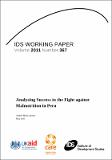Analysing success in the fight against malnutrition in Peru
Abstract
The prevalence of underweight children worldwide fell from 31per cent in 1990 to 26 per cent
in 2008 (UNICEF 2009). However, progress is still slow and very uneven. Half of the
countries have made progress on hunger, but levels of malnutrition did not improve in 28
countries and got worse in 24. The case of Peru appears to be an encouraging exception to
the rule. With the support of CARE and others organisations from civil society and the donor
community, the Peruvian Government has generated the political momentum to overcome
obstacles and create national coordination structures and mechanisms, increase public (and
private) spending on programs to tackle malnutrition and align social programs with the
national nutrition strategy (known as CRECER). This included adding conditionalities on
taking children to regular growth monitoring in the Conditional Cash Transfer programme,
JUNTOS. The international aid system has also aligned itself around CRECER. After ten
years of almost no change in child chronic malnutrition (stunting) rates (25.8 per cent in
1996, and 22.9 per cent in 2005 – with rural rates moving from 40.4 per cent to 40.1 per
cent), this change in strategy has started to lead to results: malnutrition rates fell to 17.9 per
cent between 2005 and 2010, with reductions mainly occurring in rural areas where
malnutrition rates are highest (from 40.1per cent in 2005 to 31.3 per cent in 2010) according
to the Peruvian National Statistical Office (INEI). Over 130,000 children under five are now
not chronically malnourished who would have been had rates not fallen. Indeed, there is a
strong case to be made that these changes would not have occurred without the formation in
early 2006 of the Child Nutrition Initiative, and its advocacy success in getting ten
Presidential candidates to sign a commitment to reduce chronic malnutrition in children under
five by 5 per cent in five years (‘5 by 5 by 5’), followed by the support provided subsequently
to the new government to meet that commitment.
This paper documents and systematises Peru’s recent experience in tackling malnutrition.
Through an intensive review of quantitative and qualitative evidence, it argues that success
is not explained by the presence of favourable socioeconomic changes in Peru, and it
explores the political determinants of success in three dimensions. Horizontally, it looks at
government efforts to form policy coalitions across representatives of different government
and non-government agencies; it looks at the vertical integration of agencies and
programmes between national, regional and municipal governments, and it analyses the
allocation of government resources used to fund the government’s nutrition effort.
In closing, the paper identifies some salient challenges to ensure long term sustainability of
the initiative and draws policy recommendations and knowledge sharing lessons that could
be of use for Southern Governments, donor agencies and civil society organisations.
Keywords: Peru; political economy; malnutrition; sub national politics; poverty reduction;
political parties.
Citation
Mejía Acosta, A. (2011) Analysing success in the fight against malnutrition in Peru. Working paper series, 367. Brighton: IDS.Is part of series
IDS working papers;367Rights holder
Institute of Development StudiesCollections
- IDS Research [1671]

